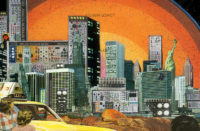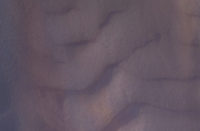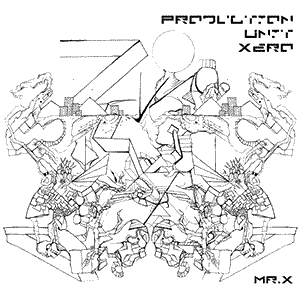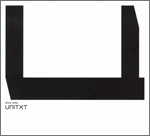
(02.08.09) Carsten Nicolai has made a virtue out of scavenging around the least musically promising audio areas, his engineering prowess deployed to making random clatter and idle chatter matter. In some ways this latest Alva Noto chapter is a late-modernist revisiting of the Kraftwerkian Mensch-Maschine theme: earlier tracks suggest the absorption into the human of the opposite-of-human, while the final clips of source codings might highlight the utter alienness of machine life – nodding toward a post-millenial nausea engendered by up-close encounter with pure process detached from human engagement. Or maybe not… You decide.
Unwonted blurts of comms apparatus (fax machines, telephones) are combined with digital detritus (glitch, fizz, static) hinting at the music of chance, the latent anima in the inanimate, the transcendent in the banal. Opening with “U_07” and its robo-recital of wallet contents reduced to dead data, an early keynote to this theme – a cybernetic negative to the ‘positive’ snapshot of humanised info-overflow, Unitxt points to a world reducible to units, to Nicolai’s compositional mode involving a 120-bpm grid and recombinations of various rhythmic units, as well as to ‘text’-as-communications, and specific text fragments ideated herein with French sound poet, Anne-James Chaton.
Ten tracks form the album’s essence; then come fifteen fragments in which non-audio material is given audio-flight. Propulsive synco-funk predominates, as on earlier Noto (Mille Plateaux) releases, but though Unitxt’s sound is recognizable wrought from similar metals, its grain is grubbier, corporeality more corroded. It reaches back in fact beyond the lusher drone thrones of the recent Xerrox and the previous For to the Trans cycle. Unitxt is still a clinical precision-tooled affair, but packs the kind of hefty clout R-N began to tap in 2007 with Robotron and Rhythm. The vocab and grammar remain the same – juddering pulses from virtual kicks, bleeps, blips, and blurts – both supertweeter-twiddling and subwoofer-scrubbing, and sundry rustling scraping skronking digi-fluvia. Here though they’re pushed further to their funkiest thunkiest thrum-drum full-onness, as pure sine tones and clipped percussive parts dovetail with a fiercer dirtier dimension. “U_06” and “U_09-1-2”, for example, are exuberantly pummelling workshops of thudding bass, chiselling treble, hiss-scratches and fizz-smears. The latter source code tracks – forming the final eight minutes – are chunks of hard data (executable programs) transposed into soundfiles. While discharging Nicolai’s conceptual brief, the tracks themselves are little more than a collection of po-mo curios. And overall, it has to be said, however compelling the rhythms, however grittily involving the source manipulations, the invariate nature of Unitxt’s sound design, the wilful myopia of its minimalism, ultimately comes to seem more defect than merit.
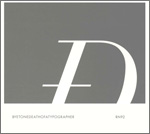
After which Byetone’s Death of a Typographer seems a paragon of organic warmth. The title perches allusively somewhere between a Greenaway film and Barthes’ concept of the death of the author. The latter is apt perhaps, since, as one of the co-founders of the Raster-Noton label, the graphic ghost in the machine in fact, Olaf Bender has put his stamp on the self-consciously cold, clinical blueprint of the imprint’s image, and may be self-referentially signalling something final related to his (and the label’s?) authorial identity. For DoaT sees something of a shift, parallelling, actually going further than, that of Nicolai, as a world of deeper and more visceral texture and tempo is entered into. Early Byetone – R-N’s 20′ to 2000 series and Feld on Bine – was a distinctly austere aesthetic of sinetone, static and click. DoaT, though, fattens up its stick-figure Kraftwerk-ophile rhythmicity and ups the melody:noise ratio, flirting more with convention, even as it retains reminders of removal from it.
Hitched to its notably less stuttering rhythms are sinewy synth threads – or rather hawsers – that shun the installation scene, wrapped/rapt around/in electro industrial-land. “Plastic Star” is perhaps the best, nailing bold stripes of synthdrone to its mechanik mast – an insistent propulsive undercarriage to rival Pan Sonic in its reined-in intensity with a buzzing robo-callisthenics redolent of Tri Repetae updated. “Black is Black” channels old-school electro through Max/MSP, while “Rocky (Soft)” translates/sublimates hardcore and techno energies into ambient buzz, kick-pulse pleasure and bass synth bliss. The whole, then, is far less freeze-dried than R-N regulation issue. Most tracks are dance-referencing if not strictly dancing come-ons, though there is the occasional deliberate hiatus; like on the diptych “Capture This” where “(I)” hovers draped in veils of Niblockian digi-drones before “(II)”‘s thick click+pulse base is launched to carry it forward in broody bit-funk beauty. “Grand Style” reminds again (cf. Unitxt) of alignments with Signal (Robotron) and a more feisty and flextoned slave to a less brittle Bretschneider Rhythm. In sum, Bender’s bent remains structure-reductive, but DoaT sees a change of strategy and means. Resonance and depth now unite to see Byetone storm (out of) the laboratory towards a more dancefloor-modelling studio.
Unitxt and The Death of a Typographer are both out now on Raster-Noton. [Purchase Unitxt] [Purchase TDT
]






